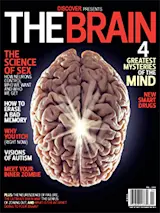Love is celebrated as a many-splendored thing, while lust is commonly regarded as downright primitive. Leave it to a Frenchwoman to discover that sexual desire is actually quite brainy. Stephanie Ortigue, an assistant professor of psychology at Syracuse University, uses brain scans to examine the divine madness of love and the blinding imperative of lust. Her goal: illuminating how these two forms of attraction work by mapping out which brain regions are active when we experience them. Her findings counter the assumption that desire is a simple animal urge motivated primarily by biochemistry and evolutionary directives.
Working with her frequent collaborator, psychiatrist Francesco Bianchi-Demicheli of Geneva University Hospital in Switzerland, Ortigue has found that lust involves complicated cognitive processing. Love, too, is not quite what we thought. Both romance and desire, she says, may be expressions of a “top-down” process in which intellect rules over instinct, not the other way ...














